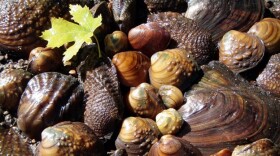I remember walking into the first day of my Diversity of Fishes class and Dr. McCune at Cornell University saying ‘welcome all my fishes’? It was such an odd statement that set the tone for an exploration into evolutionary storytelling and reevaluation of my own teaching and learning journey.
Humans have used language to place things and beings into categories, relationships, food groups, and safe or non-safe designations for thousands of years. Names often align with how people interact with and perceive the world, and, like languages, names adapt as understanding changes over time.
‘Fish’ is one of those words, useful in the image it evokes but less reliable as a lineage, clearly defined. Nested between sharks and bony fishes; humans, and all furry, scaly or feathered land-dwelling creatures, occupy a single branch of the tree of life that shares a node with lobe-finned fish like the coelacanth and lung fish. Put simply, bass and walleye are more closely related to humans than they are to other fish like sharks, lamprey, or hagfish. This, at its core was the intrigue that guided me through the semester as we learned tales of body forms, feeding and mating strategies, and cool extremes in fishy colors and behaviors.
Not only did my forever understanding of ‘fish’ change, I also discovered a new way of learning. Instead of simply looking at vials of dead fish in museum jars and having to memorize name after name of each group, the tree of relationships provided context and framed the names, shapes, and behaviors of each fish into a story of history. Gains and losses of traits were described and shown among cousin groups. Unique characteristics, such as the brightly colored males of stream darters and the giant flat rostrum of river paddlefish, stood out and generated inquiry.
Over time, I have learned of many practical applications that benefit from understanding how organisms relate and diverge from each other. For example, chemicals developed to control invasive sea lamprey throughout the Great Lakes region target metabolic and physiologic features specific to the lamprey. This allows us to apply treatments that remove the lamprey while not harming other local fish and terrestrial species. As another example, invading jumpy carp throughout Midwestern rivers have special connections between their swim bladders and inner ear that make them sensitive to specific underwater sounds. By understanding this unique trait, we can build low-cost sound barriers to help limit their dispersal and further invasions.
The name ‘fish’ is not alone! If we look closely and more deeply, many common names like ‘bug’, ‘plankton’, and ‘algae’ are similar mishmashes of distantly related groups who share some similar features. These names are still useful for most everyday conversation, but they overlook the millions of years of divergence and intricate adaptations that have allowed for beauty and diversity inherent within each group. True understanding requires looking beyond the surface: of the water, of the word, of the world, to keep our inquisitive and learning perspective, even when it comes to something as simple as calling a fish a ‘fish’.









